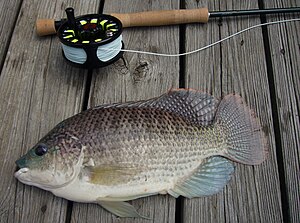Blue tilapia
| Blue tilapia | ||||||||||||
|---|---|---|---|---|---|---|---|---|---|---|---|---|

A blue tilapia fished in a reservoir in North Carolina |
||||||||||||
| Systematics | ||||||||||||
|
||||||||||||
| Scientific name | ||||||||||||
| Oreochromis aureus | ||||||||||||
| ( Steindachner , 1864) |
The blue tilapia ( Oreochromis aureus ) is a species of fish from the family of the cichlids (Cichlidae) that is found in West Africa in Senegal , in the upper and middle Niger , in the Benue , in many waters of the Chad Basin as well as in the lower reaches of the Nile and in the Jordan in the Middle East occurs. It was introduced by humans to Southeast Asia, South and Central America, the United States, and the Azraq Oasis in Jordan . The blue tilapia is a valued food fish, its meat is tasty and has few bones.
features
The blue tilapia can grow to be around 45 cm long and weigh 2 kg. It has a very high back and laterally flattened body. The body height is more than 50% of the standard length . The sexual dimorphism is clearly pronounced due to the significantly larger males, which are equipped with more powerful fins. Young fish are dark gray-brown to pale gold in color. A tilapia spot is present, but in most cases it has disappeared in fish more than 10 cm long. Adult males are gray-blue in color with a darker back and a silvery-gray belly. There are silvery and dark dots all over the body and, depending on the mood, also dark transverse bands. They are blue-green between the eyes and the upper lip. During the breeding season they have a metallic blue shine on the head. The soft-rayed sections of the dorsal and anal fin and the caudal fin are lined with vermilion, pink or orange-red. Females are more plainly colored, in mouth-brooding females the edges of the dorsal and caudal fin are bright orange. In contrast to the Nile tilapia ( Oreochromis niloticus ), the blue tilapia has no vertical stripes on the caudal fin.
- Fins formula : dorsal XIV – XVII / 11–15, anals III / 8–11.
- Vertebra: 28-31.
Like many phytoplankton eaters, the blue tilapia has numerous, very small teeth.
Way of life
The blue tilapia occurs in many different freshwater habitats, which can be rivers, lakes, ponds or irrigation channels, both in open water and between vegetation or stones. The species has a high temperature tolerance (8 to 30 ° C, for a short time also 41 ° C) and can also tolerate brackish water . It forms small schools but is territorial during reproduction. The blue tilapia feeds mainly on phytoplankton ; in addition, small amounts of zooplankton are also taken up. Young fish mainly eat copepods , water fleas and other small invertebrates. Like all Oreochromis species, the blue tilapia is an ovophilic mouthbrooder in which the breeding business is only carried out by the female. The fish can reproduce in fresh and brackish water. In pond systems, the juvenile fish become sexually mature at an age of five to six months.
literature
- Anton Lamboj: The cichlids of western Africa. Publisher: Natur und Tier, 2006, ISBN 386-659000-8 , p. 37 u. 38.
Web links
- Blue Tilapia on Fishbase.org (English)